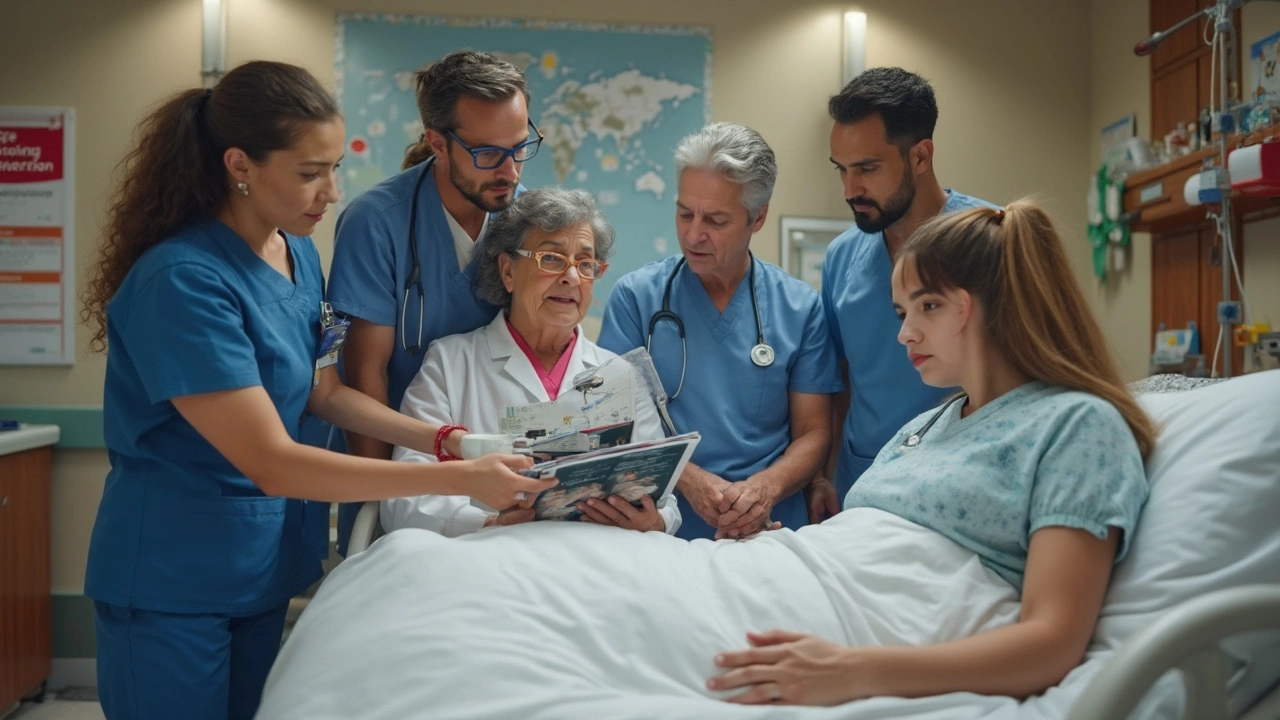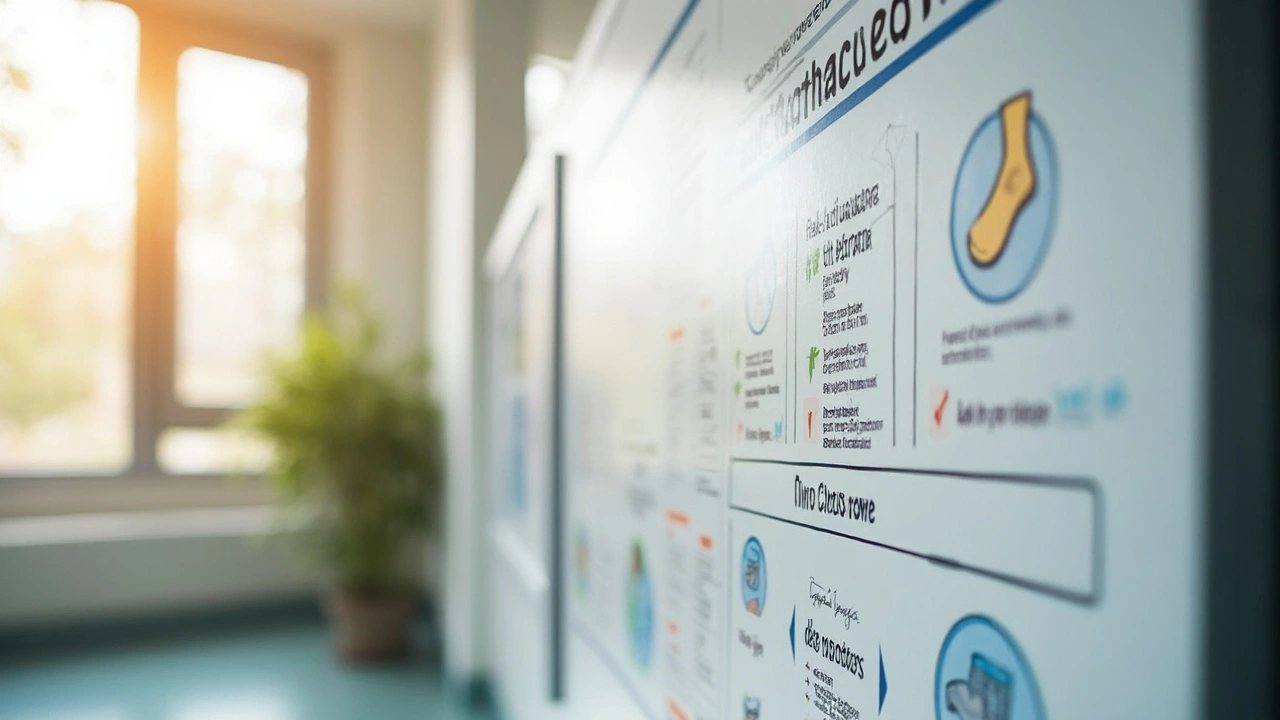
Why Surgery Gets Riskier: Understanding the High-Risk Trio
Most people think of blood clots as something that happens by chance, but in surgery, the risks can stack up fast—especially for those living with diabetes, obesity, or cancer. Here's where the numbers get a bit unsettling: compared to an average person, someone with one of these conditions can face up to a five times higher chance of a serious post-surgical clot. Mix in more than one risk factor? Those odds shoot up again. What happens during surgery is a perfect storm for clot formation. A body under anesthesia isn't moving, the blood tends to pool and slow down, and the blood chemistry can shift. Now toss in diabetes, which thickens and damages blood vessels, or obesity, which adds pressure and hidden inflammation, or cancer, which churns out clotting factors as part of the disease itself. It's not just adding one risk on top of another; these conditions multiply each other's effects in scary ways.
Doctors see this all the time: a patient with a BMI over 35 or blood sugar that swings outside the safe range whose operation should be straightforward suddenly needs aggressive prevention strategies. For people with cancer—especially those with tumours in the pancreas, stomach, or brain—the body is almost programmed to form clots. If you've got more than one of these risk factors, you really can't rely on standard clot prevention plans. Sometimes, surgeons even delay non-emergency procedures just to get things more stable first. It's not just about what might happen; there's strong data showing clots are one of the top three causes of preventable hospital deaths after an operation. And it's not just deep vein thrombosis (DVT) we're talking about—clots can travel up to the lungs, causing a life-threatening pulmonary embolism. These don't always happen right away; they can strike days or even weeks after going home.
So it's absolutely crucial that anyone in the high-risk group knows their enemy. Recognizing the overlap between diabetes, obesity, and cancer isn't just useful—it's lifesaving. Your risks aren't hidden from your doctors, but you should know them for yourself too. That way, you can ask the right questions and be your biggest advocate.
Surgical Planning: Tailoring the Approach for High-Risk Patients
Before anyone even puts on a hospital gown, the real work of clot prevention starts with pre-op planning. For people with diabetes, the surgeon will want recent blood sugar readings and possibly an HbA1c test to see how well blood sugar’s been controlled over months. Unmanaged diabetes creates thick, sticky blood that clots easily. High-risk patients often need their medicine adjusted in the days before and after surgery, sometimes swapping medications or changing doses to keep things stable. Surgeons and anaesthetists may also choose anesthesia types that encourage faster wake-up and movement, since getting out of bed means blood keeps flowing.
Obesity pushes doctors to look at more than just body weight. They consider waist size, breathing issues (like sleep apnea), and even whether the patient might miss early warning signs of a clot—pain or swelling could be masked in larger limbs. For very high BMIs, pre-op weight loss isn't just about shrinking numbers on a scale—studies show even losing 5-10% of body weight before a big operation can lower clot risk.
Cancer patients face a different set of planning steps. Some cancers actually release chemicals that trick the body into clotting, so surgery teams may order extra blood tests to spot hidden risks. Planning could mean pre-op blood thinners, compression stockings, and more frequent bloodwork. Some surgeons will delay or adjust operative plans if a patient just had chemo, since chemotherapy itself can make blood more prone to clotting.
Every detail matters: from how long the surgery is expected to last (longer time under means higher clot risk), to where and how incisions are made, to which medicines are safe to give. Having realistic conversations about risks and what you can do to help brings some control back into what can feel like a nerve-wracking process. The best surgical teams use a checklist approach—what risks are present, what can be done, who's responsible for each step—so nothing gets missed.

In the Thick of It: Extra Measures During and After Surgery
It's game time in the operating theatre, and for high-risk patients, there's an extra layer of action happening that most people never see. Doctors might start low-dose blood thinners even as surgery begins—yes, it seems weird to thin blood during an operation, but the doses are calculated to balance both bleeding risk and the need to stop clots. These medicines are sometimes kept going for days after surgery, not just for the hours in the OR. Specialized compression stockings or pneumatic devices (those sleeves that squeeze the legs during and after surgery) are a must, because they keep blood moving in deep veins. For anyone with diabetes, careful blood sugar monitoring is done throughout—the idea is to keep glucose close to normal, since wild swings make blood stickier and vessels crankier.
Nurses, doctors, and anaesthetists all watch closely for hints of trouble: pain, redness, or warmth in the legs; shortness of breath; or a racing heart. High-risk patients may also have extra leg ultrasounds or blood tests to screen for clots before symptoms show. Don't be surprised if you're asked to wiggle your feet or flex your ankles every couple of hours—it's much more than boredom busting, it's real prevention. And for some extremely high-risk folks—like those with aggressive cancers or old blood clots—there's a conversation about putting in a filter (called an IVC filter) to physically catch clots before they travel up to the lungs. These aren't for everyone, but it's the kind of tool that only comes into play for the highest risk cases.
Mobility is the unsung hero here. Studies keep proving that the sooner you can get out of bed and take a few steps (under supervision, obviously), the lower your risk of ending up with a dangerous clot. Even if walking isn't totally safe, sitting up and moving legs in bed helps more than you'd think. Hospital staff are relentless for a good reason—they've seen what can go wrong when blood just sits still. Those little reminders to move aren't nagging; they're possibly the single simplest thing you can do to cut your risk way down.
What Happens When You Come Home: Vigilance and Self-Advocacy
Heading home after an operation sounds like the finish line, but for high-risk patients, the threat of clots is often highest in the days and weeks after discharge. You're suddenly out from under the 24/7 hospital watch, and it's easy to chalk up leg pain or swelling to normal recovery aches. Problem is, blood clots can sneak up quietly. More than half of post-surgical clots show up once patients are off the hospital radar. That's why extra vigilance is non-negotiable.
If your plan included blood thinner injections or tablets, take them as instructed—even if you feel back to normal. Missing doses, stopping early, or skipping refills opens the door to trouble. It might be tedious, but learning to spot the classic warning signs—unexplained swelling, warmth, or redness in a leg; suddenly feeling short of breath; chest pain—could save your life. If it feels off, get checked straightaway, even if you think it’s probably nothing.
Here's a big tip most people miss: dehydration after surgery is surprisingly common, especially if you're not eating or drinking well. Blood that's low on liquid gets thicker, and thick blood clots easier. Make hydration a top priority, and keep moving as much as you’re able (but don’t overdo it—there’s a sweet spot here). Family or friends should know the clot warning signs, because they might see something you miss.
Check with your team about how long you need to keep up these precautions—some high-risk patients are kept on blood thinners for a month or more. It feels long, but the science backs it: extended prevention after surgery in high-risk groups slashes the chance of dangerous clots by almost half. Don’t let refills run out, and if you’re worried about side effects (like bruising or bleeding), talk to your GP or surgeon instead of stopping on your own.
It also helps to have a good read on your risk level. Online resources, like this post on preventing clots in high-risk patients, lay out step-by-step strategies you can use at home and set reminders for follow-up care. Being proactive here isn’t paranoia—it’s good sense, especially in places like Auckland with high obesity and diabetes rates. Recovery is not just about the surgery itself; it’s about making it through the first few months without a hidden setback.

Smart Strategies You Can Start Now
You don’t have to wait for surgery day to get your clot risk down. The prep starts long before you see a surgeon. If you live with diabetes, keeping blood sugar as close to target as possible (ask about your A1c goal) makes a huge difference. If you’re carrying extra weight, even modest progress helps—don’t underestimate the power of dropping a few kilos. For those with cancer, talk openly with your medical team about clot risks. Some chemo drugs make clots more likely, so this is a must-discuss topic.
Build a simple pre-surgery checklist:
- Ask if you need extra bloodwork for clotting risks.
- Double-check medication changes (this can include stopping certain drugs or starting something new).
- Find out exactly when you can start moving after surgery—make a plan for getting help if you’ll need it.
- Set reminders for blood thinner doses and follow-up appointments.
- Share warning signs of clots with someone you trust so they can spot symptoms, too.
- Ask if you’re a candidate for extra tools like compression stockings or, in rare cases, clot filters.
If numbers help you stay motivated, have a look at this:
| Risk Factor | Average Clot Rate (%) | With Prevention (%) |
|---|---|---|
| Standard Patient | 1-2% | <0.5% |
| Diabetes | 4-5% | 1-2% |
| Obesity | 5-6% | 1-2.5% |
| Cancer | 7-10% | 2-5% |
This shows just how big a drop you can get with the right prevention in place. Don't be shy about bringing these questions to your surgical team—they expect it, and it means you're engaged in your own outcome. Your voice matters as much as any medicine or machine when navigating high-risk surgery. Be armed with questions, and don’t leave anything to chance.





Comments (11)
mathokozo mbuzi
This is a highly important discussion, especially considering how vulnerable patients with diabetes, obesity, and cancer are during surgery. The article's focus on tailored prevention strategies is commendable because a one-size-fits-all approach often fails to consider individual patient risks.
What particularly intrigues me is how surgical planning can be adjusted to mitigate clot risks effectively. I wonder if the article delves into newer pharmacological agents or mechanical devices as part of post-op care. Also, considering resource differences globally, some strategies might be harder to implement in less equipped hospitals.
Discussing the practical questions that patients should ask their surgical teams is also crucial. It empowers patients to be proactive about their health outcomes. Have any of you encountered situations where such discussions have significantly changed surgical protocols or outcomes?
Amy Aims
Wow, such a vital topic for those facing surgery with these complex conditions! It’s reassuring to know that there are concrete strategies for clot prevention tailored to these high-risk groups. The inclusion of actionable tips and encouraging patients to ask questions is so empowering. 😊
It can be really scary to think about blood clots after surgery, but having clear information and a practical resource could really ease some of that anxiety. I’m curious about the types of post-op care recommended—are there lifestyle changes or specific medications suggested?
Hopefully, this helps many people get through surgery safely and with more confidence in their recovery journey!
Aayush Shastri
Such an insightful post! When you consider the intersectionality of diabetes, obesity, and cancer, the risk factors multiply, making clot prevention strategies absolutely critical.
I appreciate that the article provides real-world advice rather than just theoretical knowledge because patients and doctors both benefit greatly from evidence-backed practices. I wonder if there’s mention of patient education programs as part of the pre-op preparation — that tends to improve adherence to post-op regimens significantly.
Does anyone know if insurance companies recognize these high-risk protocols? Sometimes, coverage impacts the extent of preventive measures a patient can access.
Sen Đá
While the discussion is certainly important, it would be critical to also examine how robust the evidence is regarding these clot prevention strategies. Are these strategies coming from randomized control trials or observational studies? Without solid evidence, we risk recommending interventions that may not produce optimal outcomes.
Additionally, the nuances of treatment in diabetic versus obese patients can vary significantly. A generalized approach may be ineffective or even harmful for some subsets. I hope the article emphasizes personalized medicine strongly.
The call for patients to question their surgical teams is good, but I would urge caution in assuming patients always have the knowledge or ability to challenge complex medical decisions effectively.
LEE DM
This is a great article, especially because it highlights the need to tailor clot prevention to individual patient risks, including diabetes, obesity, and cancer. These conditions require distinct considerations which often get overlooked in general surgical protocols.
I also like the focus on real-world advice, which is often what patients and caregivers need most. More so, encouraging patients to ask questions promotes a transparent and inclusive healthcare experience. We need to think about cultural factors here too because the way patients communicate with their doctors can vary widely.
Are there recommendations on how healthcare teams can better support patients from diverse backgrounds in understanding their risk and prevention strategies?
Penny X
Honestly, this topic just screams for more awareness. We're talking about life-and-death situations here! Blood clots can totally sneak up on patients post-op, and if the article lays out clear, evidence-backed strategies, more power to it.
But I have to wonder — are the suggestions realistic? Sometimes medical teams get locked into their routines, and patients get the short end of the stick. Plus, the psychological stress on patients with these conditions can’t be ignored. Are these addressed?
I’d love to see healthcare systems take this seriously and not skim over the nuances. Without that, even good strategies might fail to save lives.
Shaik Basha
Heyyy guys! This article really hits a spot coz my da had surgery and he’s diabetic n stuff. 😞
Appreciate stuff like this that dives into prevention cause blood clots freak me out big time. Kinda wanna know what kinda post-op tips they mean? Like are we talkin meds, exercises, diet changes? Would love some simple explanations cos docs sometimes talk so fancy lol.
Also, would be awesome if they mention what patients can do at home to help avoid clots. I think stuff like hydration and some light movement might help but not sure exactly.
Stephanie Zuidervliet
Omg y'know what's really maddening? When important info like this gets buried and ppl end up confused post-surgery!
It’s great the article includes tips on what questions to ask, because honestly, no one should feel left in the dark. But I wish healthcare providers were just more upfront and communicative to begin with without us having to fish for info.
Plus, diabetes, obesity, and cancer aren’t just medical conditions; they come with so much stigma and emotional baggage which can impact how patients engage with prevention strategies. We can't ignore that drama.
Anyway, anyone read about how these strategies actually change patient outcomes long term?
Michael Ieradi
The intricacies of managing clot risks in these conditions cannot be overstated. While it is crucial to apply evidence-based protocols, it is equally important to ensure adherence and patient understanding.
Post-operative care protocols must include thorough education about signs to watch for and clear guidance on medication adherence. I would be interested to know if the resource provided also supports caregivers who often play a vital role in recovery.
It's also imperative that surgical teams are accessible and willing to discuss these risks openly before and after surgery. This transparency leads to better outcomes and trust.
Olivia Crowe
This subject is so close to my heart! I lost my aunt to a post-op clot related complication. The emphasis on tailored prevention is something I wish all patients knew about before going under the knife.
Knowing the risks and having clear instructions is empowering. The article sounds like it offers hope and solid advice for those navigating this tough path. 😊💕
I'd love to hear from others about their experiences and if any of these strategies worked well in practice. Sharing positives can really uplift the community!
Hannah Gorman
While I commend the article for tackling the complex relationship between diabetes, obesity, cancer, and post-surgical thrombotic risks, I often find that such discussions lack critical attention to socioeconomic factors.
Access to optimal preventive measures can be heavily influenced by insurance status, geographical location, and the quality of the healthcare system itself. It would be naïve to believe strategies can be universally applicable without context.
Moreover, I would advise the surgical teams to integrate interdisciplinary approaches, including nutritionists, physiotherapists, and psychologists, to address the holistic needs of these vulnerable patients. Only then can prevention efforts truly be effective and sustainable.